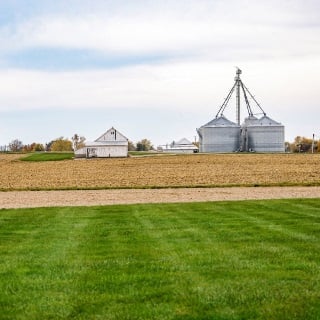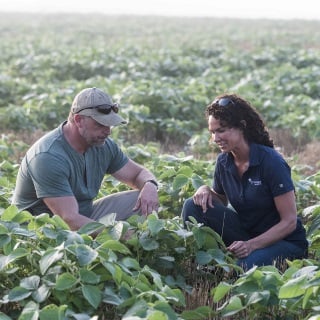Agriculture has faced significant economic pressure in recent years, and producers continue to experience tight margins and financial strain as they enter 2025, according to USDA’s Economic Research Service (ERS). After net farm income peaked at record highs in 2022, the USDA ERS has reported a steady decline year over year. Net farm income is projected to drop by $8.2 billion, or 5.6%, in 2024. This decline is attributed to several factors, including fluctuating commodity prices, increased input costs and market volatility.
Although USDA’s ERS noted a decrease in production expenses in 2024, the dramatic reduction in cash receipts for soybeans and corn specifically outweighed these gains, further tightening margins for these producers. Cash receipts have been adversely affected by lower market prices and reduced demand in certain sectors.
Additionally, the agricultural sector has been impacted by a range of external factors. Trade disruptions and global economic conditions have further compounded these challenges.
Together, these external factors have created a challenging environment for many producers, requiring them to be resilient and adaptable in the face of ongoing economic and environmental pressures.
To alleviate some of these pressures Congress recently enacted the American Relief Act (H.R. 10545), which included a one-year Farm Bill extension, disaster relief, and introduced the Emergency Commodity Assistance Program (ECAP). Passed on December 21, 2024, this legislation provides financial relief to producers of eligible commodities.
Key Provisions of the American Relief Act
The American Relief Act includes several measures aimed at supporting agricultural producers:
First, it extended the 2018 Farm Bill through September 30, 2025, paving the way for producers to continue to access critical programs like crop insurance and protect their operations against losses due to weather events or poor yields. They may continue to utilize Price Loss Coverage (PLC) and Agriculture Risk Coverage (ARC) programs. (Enrollment decisions for the 2025 production year are required by March 15, 2025.)
The Farm Bill extension also kept available programs that stabilize commodity prices during market downturns, maintained access to federal recovery funds from natural disasters.
Second, it allocated nearly $21 billion to help producers recover from losses due to weather events such as droughts, hurricanes, floods, and excessive heat during the 2023 and 2024 production years. The USDA has not yet provided specifics on how these funds will be distributed but additional information is expected soon.
Finally, the American Relief Act allocated $10 billion for payments that address losses tied to the 2024 production year through the ECAP program. With the official program details released on March 18th, we now know payments will be calculated based on USDA’s ERS production cost projections and expected gross returns, which are derived from December 2024 World Agricultural Supply and Demand Estimates (WASDE) report forecasts and a 10-year national average yield.
For producers who derive less than 75% of their average gross income from farming, ranching or forestry activities, the payment limit will be $125,000. Those who receive more than 75% of their income from these activities will be limited to $250,000. These averages will be calculated based on a three-year average from 2020, 2021 and 2022 of the reported “total income” on IRS form 1040, 1041, 1065 and 1120, or similar form. These payment limits are designed to provide targeted relief, ensuring assistance is distributed in a way that supports both small and large producers while maintaining the overall sustainability of the program.
Eligible payments will be available to both planted acres and 50% of prevent plant acres and will be based on acreage reported on FSA-578 and FSA-576 forms and not based on production.
On the program start date, March 19, 2025, the Farm Service Agency (FSA) will begin mailing pre-filled ECAP applications to all producers who have reported an eligible commodity as of March 10, 2025. After verifying and completing Form FSA-63 ECAP, producers should submit their application to their local FSA county office. Alternatively, producers may also complete their application online using a secure login.gov account, in-person, or via fax. One application will cover a producer’s entire operation nationwide. Most importantly, producers must submit their completed ECAP applications by August 15, 2025, to ensure eligibility for funding. The March 18th release also included details about eligible commodities and ECAP payment rates on a per acre basis. Producers may access an ECAP Calculator at fsa.usda.gov/ecap to calculate estimated payments. It is important to note that initial ECAP payments will be factored by 85 percent to ensure total program payments do not exceed available funding. If funds remain after initial disbursements, FSA may issue a second round of payments to eligible producers.
| Commodity | Per-Acre Rate |
|---|---|
| Barley | $21.67 |
| Corn | $42.91 |
| Dry peas | $16.02 |
| Large Chickpeas | $24.02 |
| Lentils | $19.30 |
| Long & medium grain rice | $76.94 |
| Oats | $77.66 |
| Peanuts | $75.51 |
| Small Chickpeas | $31.45 |
| Sorghum | $42.52 |
| Soybeans | $29.76 |
| Upland cotton & Extra-long staple cotton | $84.74 |
| Wheat | $30.69 |
Eligible Oilseeds | |
| Canola | $31.83 |
| Crambe | $19.08 |
| Flax | $20.97 |
| Mustard | $11.36 |
| Rapeseed | $23.63 |
| Safflower | $26.32 |
| Sesame | $16.83 |
| Sunflower | $27.23 |
Looking Ahead
As details about the American Relief Act, including information about the $21 billion disaster relief money, continue to evolve, Farm Credit Mid-America is committed to providing timely updates and resources to help producers stay informed. This will include regular communications, informational webinars, and guidance documents to ensure all stakeholders have access as more information becomes available. Producers should also work closely with their local FSA office to confirm program eligibility, ensure all required forms are on file and receive the most up-to-date information on ECAP and disaster relief assistance.
By maintaining close communication with your Farm Credit Mid-America team, you can ensure that you are well-prepared, informed of the latest updates and able to take full advantage of relief programs like ECAP when they become available. Staying proactive and informed will be key to maximizing the benefits of the American Relief Act for your agricultural operation.
Source: Paulson, N., G. Schnitkey, C. Zulauf and J. Coppess. "Impacts of Economic Assistance Payments." farmdoc daily (15):4, Department of Agricultural and Consumer Economics, University of Illinois at Urbana-Champaign, January 7, 2025.
Source: USDA Farm Service Agency - https://www.fsa.usda.gov/ecap

.tmb-primary.jpg?sfvrsn=22334566_1)




